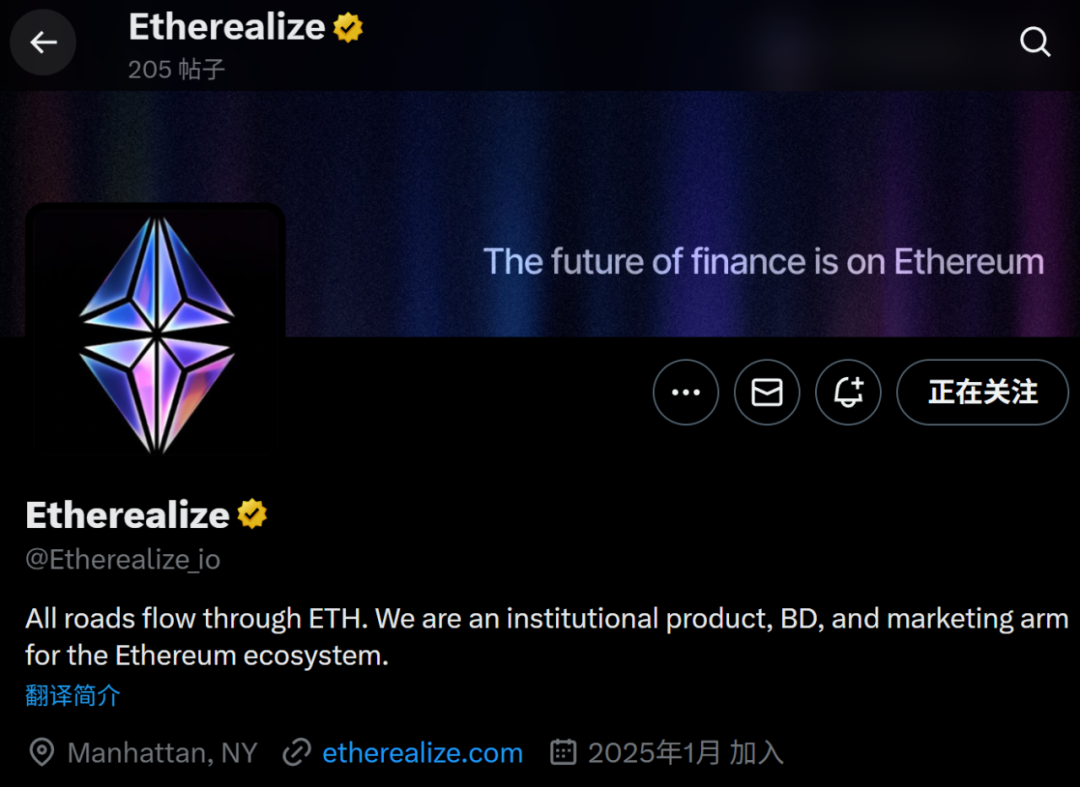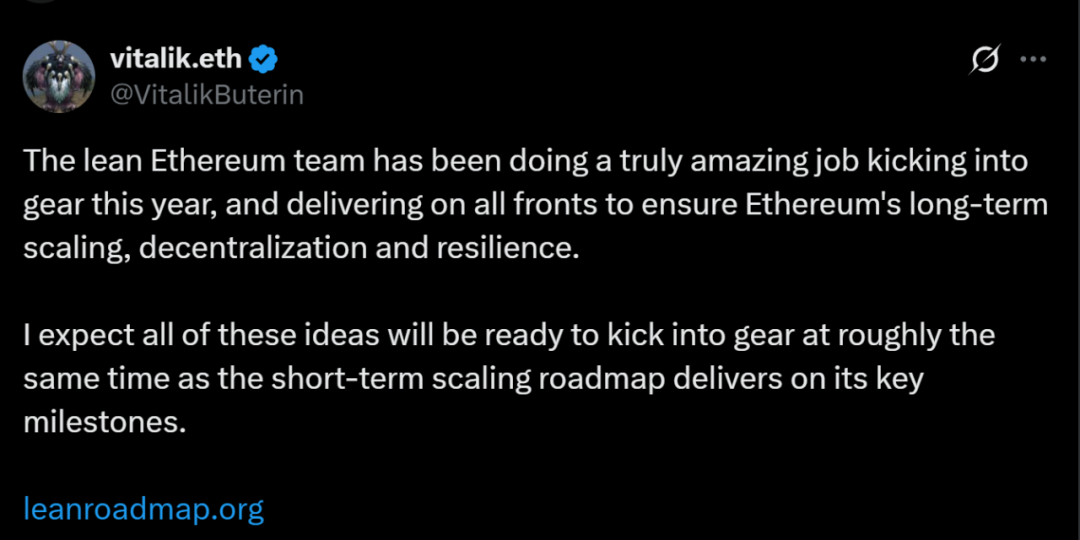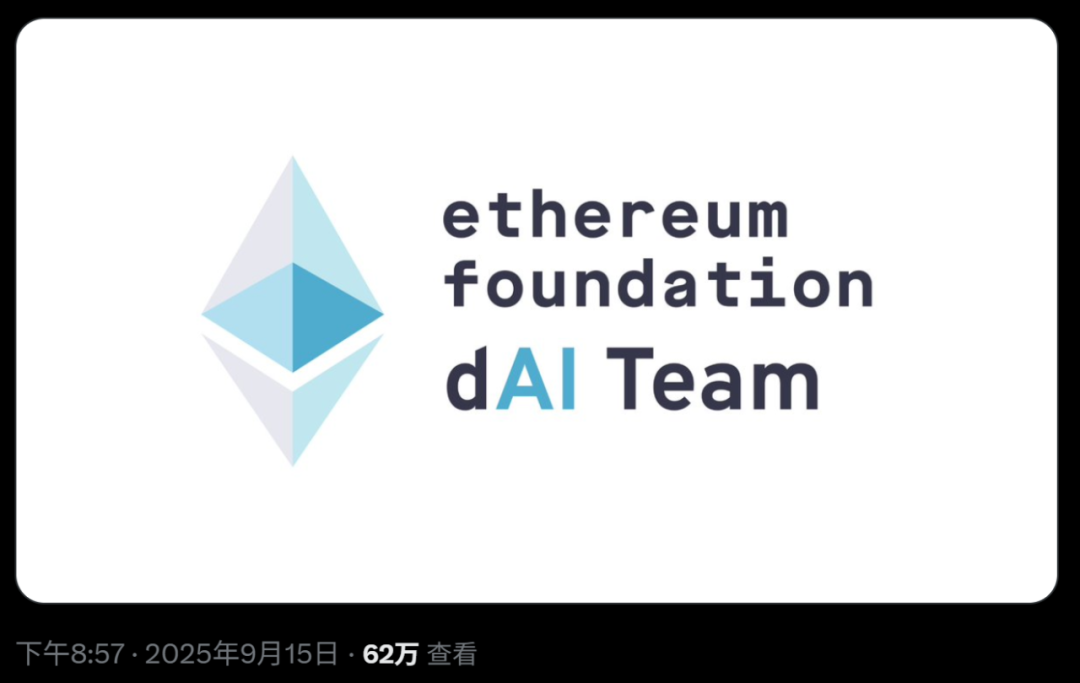On September 3, Etherealize, which claims to be an "institutional-grade product, BD, and marketing department of the Ethereum ecosystem," disclosed a $40 million financing round. In addition to Electric Capital and Paradigm leading the investment, it is noteworthy that Ethereum co-founder Vitalik Buterin and the Ethereum Foundation participated directly.
To some extent, this investment symbolizes the Ethereum community's firm support for a specialized and institutional development path, and it also sends a clear signal that Ethereum's growth logic is shifting from "scaling" to the overflow and integration of the "application layer."

Looking back, we can see that from the DeFi wave of 2020-2021, to the subsequent CeDeFi practices, and now the accelerated integration into TradFi—Ethereum's innovative approach to traditional finance is continuously evolving through "survival of the fittest."
Ethereum's development is transitioning from the "infrastructure phase" to the "application explosion and ecological reshaping phase," with a trillion-dollar "second curve" taking shape.
01. After Scaling, a New Growth Engine is Switching On
As is well known, the main theme of Ethereum's development has always been "scaling."
With the maturity of L2 Rollup solutions like Arbitrum and Optimism in recent years, and the gradual implementation of foundational protocols such as Danksharding and EIP-4844, Ethereum's basic computing capacity and throughput have significantly improved, especially as the L2 ecosystem has built a solid "execution layer" foundation.
It can be said that after years of exploration, Ethereum has initially solved the "usability" problem, but the more challenging question remains—who will use it and how will it be used?
After all, the challenges Ethereum faces have never been as severe as they are now:
- On one hand, high-performance public chains like Solana and Sui are encroaching on the on-chain market with a "faster, cheaper" positioning;
- On the other hand, traditional Web2 giants like Visa, Stripe, Paypal, Robinhood, and even Fidelity are launching their own public chains or integrating decentralized clearing and settlement systems to enhance their Crypto/TradFi layouts;
Looking back over the past five years, Ethereum has undoubtedly been a breeding ground for innovation at the application level, almost the best "composable on-chain financial laboratory," supporting the entire Web3 experimental wave from DeFi, NFT, to DAO, GameFi, and SocialFi.
However, the innovations of this phase have primarily targeted Web3 native users and are essentially still limited to the "self-circulation of on-chain capital." In other words, funds circulate on-chain, and protocols stack on-chain, but real-world assets, institutions, and users remain on the sidelines.
Web3 is logically self-consistent but struggles to connect with the demands of the real financial world. In this competitive landscape, Ethereum's "technological leadership" is no longer a moat; to continue growing, it must answer a more grand question: how to break through the boundaries of Web3 itself and become a true global asset settlement layer?
The new increment comes from outside Web3—AI's demand for computing power and traditional finance's settlement needs are simultaneously driving it into a new cycle:
The most typical example is the wave of RWA (Real World Assets) tokenization—traditional financial institutions like banks, brokerages, and fund companies are actively trying to move assets such as bonds, stocks, and fund shares onto the blockchain to achieve on-chain clearing and real-time settlement (see further reading "Ethereum Narrative Shift: From World Computer to World Ledger, On-Chain Central Banks Are Coming?").
At the same time, with the intensification of AI model and data monopolies, the AI industry is eager for a neutral and trustworthy settlement layer to address core pain points, including model and data rights confirmation, decentralized computing verification, and resisting centralized risks. In short, AI needs a globally verifiable computing layer to price trust, and blockchain itself naturally fits this demand.
Of course, to accommodate the needs of TradFi and AI, Ethereum must comprehensively upgrade in terms of performance, privacy, and modularity.
02. New Roadmap: Multi-Track Progress of zkVM, AI, and Privacy
To address these new demands, the Ethereum community and the foundation are already advancing several key strategies, with the following being the more publicly discussed directions.
First is zkVM (Zero-Knowledge Virtual Machine), which is not just a technical extension of L2 scaling but a disruptive reshaping of Ethereum's mainnet functionality. For example, the Ethereum Foundation is currently promoting a mainnet-level zkVM architecture, replacing repeated execution with zero-knowledge proofs (ZKP) for transaction validation, significantly enhancing throughput and security.
The core logic of zkVM lies in transforming the trust model, as traditional Ethereum relies on all nodes re-executing transactions to reach consensus, while the greatest advantage of zkVM is that it allows validation nodes to no longer re-execute all transactions but only verify proofs, greatly reducing synchronization and execution costs.
In this new architecture, Ethereum's mainnet is expected to become a "computational settlement layer," focusing on validating ZK proofs and anchoring the final state, while L2 becomes an efficient "execution layer," allowing Ethereum to evolve from a blockchain into a globally verifiable computing layer.
Vitalik Buterin recently praised the minimal zkVM proposed by Ethereum developers aimed at streamlining Ethereum: optimized for XMSS aggregation and recursion, leanVM minimizes commitment costs compared to Cairo through a four-instruction ISA, multi-linear STARK, and logup lookup.

Another clear signal is the establishment of the Ethereum Foundation's AI team "dAI" on September 15, dedicated to building a decentralized AI ecosystem. This also marks that Ethereum is no longer just passively "being used by AI," but is actively "integrating with AI."
The core task of the dAI team is to allocate resources to define standards, incentives, and governance structures for AI models on the blockchain, including model credibility: how to ensure the transparency of AI model training data, how to use ZK technology to prove the integrity of model inference, and the establishment of new standards—such as ERC-8004 and x402, which are being promoted by the community to better serve the AI ecosystem:
- ERC-8004: Aims to establish a "composable, accessible" decentralized AI infrastructure layer, allowing developers to easily build and integrate AI model services;
- x402: Dedicated to defining a unified on-chain payment and settlement standard, ensuring that users can conduct efficient, atomic micro-payments when accessing AI models, storing data, or using decentralized computing services on-chain;
Through these efforts, Ethereum is attempting to define the underlying protocols and settlement mechanisms for decentralized AI, positioning itself as the "value settlement and trust layer for decentralized AI."

In addition, to welcome the trillions of assets from TradFi, Ethereum must resolve the contradiction between privacy and compliance, and its privacy roadmap has begun to layer to meet the needs of different groups.
Institutional privacy and compliance (core demands of TradFi) focus on exploring compliance privacy solutions on L2/L3, meaning institutions can conduct encrypted transactions and settlements on-chain while providing auditable and verifiable transaction records to specific regulators (such as auditors and regulatory agencies) through zero-knowledge proofs or permission control mechanisms, thus protecting trade secrets while meeting regulatory requirements.
Personal privacy (protection for Web3 users) addresses MEV (Miner Extractable Value) attacks and the leakage of personal transaction data through account abstraction (AA) and privacy-enhancing technologies on L2, ensuring that users' on-chain activities are protected.
These three tracks—universality (zkVM), application boundaries (dAI/new standards), and compliance (privacy)—together form Ethereum's core strategy for addressing the demands of AI and TradFi in its "second curve."
03. What If the "Second Curve" Successfully Transitions?
Just as Ethereum has evolved from the DeFi wave of 2020-2021, to subsequent CeDeFi practices, and now actively integrating into TradFi, its innovative approach to global finance has always been about "survival of the fittest."
Therefore, Ethereum's current "super evolution" is no easy task, but once the transition is successful, its ecosystem and status will undergo a complete reshaping.
First, Ethereum will upgrade from an "application platform" aimed at Web3 native users to a "computational & financial infrastructure platform" targeting global mainstream economies, solidifying its position in the global financial system and becoming the de facto "global value settlement layer."
Following this, an increasing number of high-value businesses (such as institutional-level RWA, AI model verification, decentralized data markets) will choose to deploy directly on Ethereum or its zk-native structure, forming a massive liquidity pool and trust guarantee.
Then, the L2/Rollups ecosystem will evolve into a "collaborative network," no longer independent public chains fighting their own battles, but deeply connected with the mainnet zk layer, focusing on providing different execution environments (EVM, ZKVM, privacy customization, etc.). Ultimately, underlying stablecoins, privacy protocols, data oracles, AI model markets, and other sub-ecosystems are expected to rise, providing necessary "middleware" for institutions and AI.
Overall, the emerging Ethereum "second curve" signifies its leap from a "cryptocurrency computing layer" to a "global trust and settlement layer"—no longer just a playground for speculators, but rapidly transforming into an indispensable financial lexicon within the global economic infrastructure.
After all, the AI industry needs its trustworthy neutrality, and traditional finance requires its efficient compliance. The zkVM, AI team, and privacy roadmap are Ethereum's combined efforts to meet these two trillion-dollar demands.
Please believe that the best times are yet to come.
免责声明:本文章仅代表作者个人观点,不代表本平台的立场和观点。本文章仅供信息分享,不构成对任何人的任何投资建议。用户与作者之间的任何争议,与本平台无关。如网页中刊载的文章或图片涉及侵权,请提供相关的权利证明和身份证明发送邮件到support@aicoin.com,本平台相关工作人员将会进行核查。




